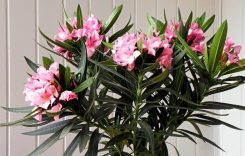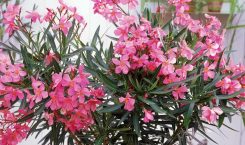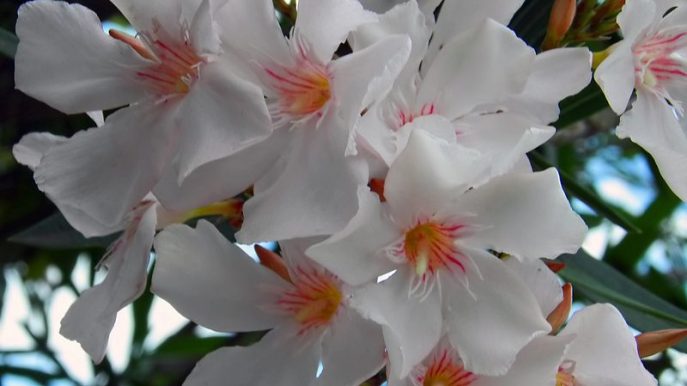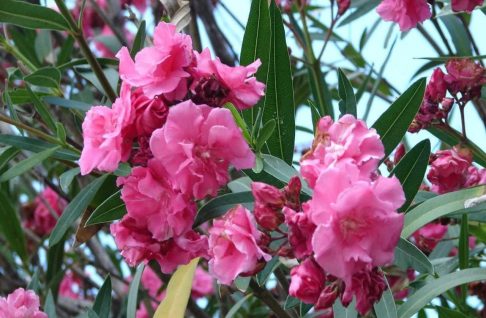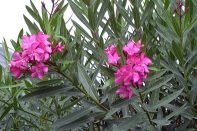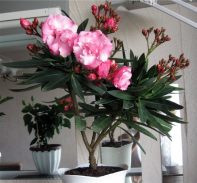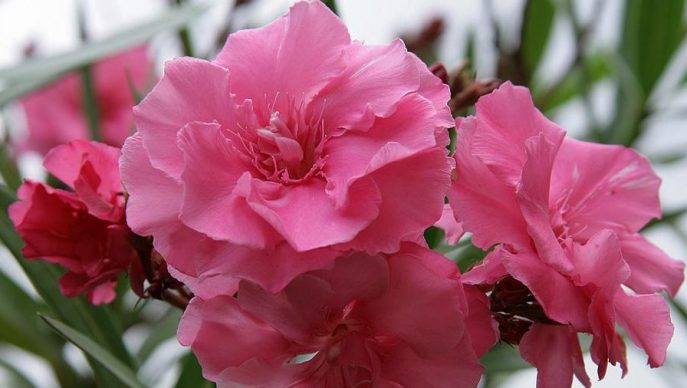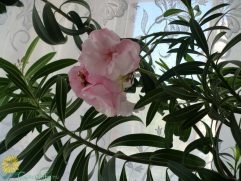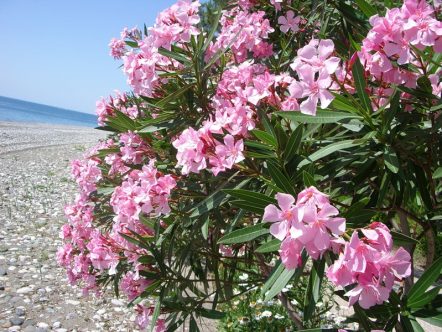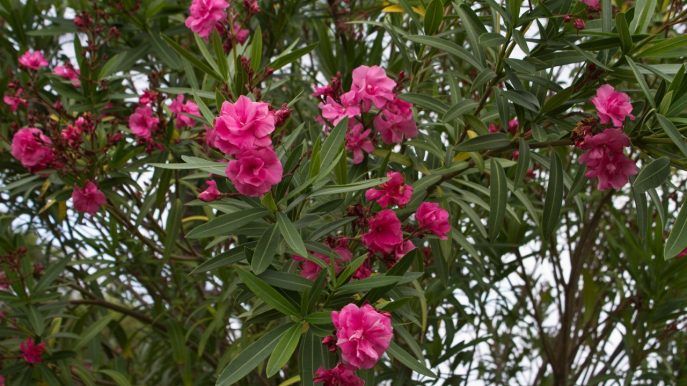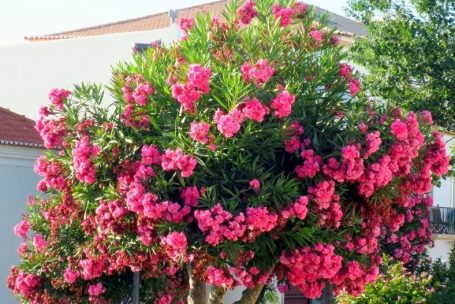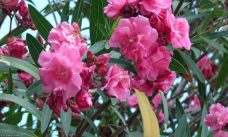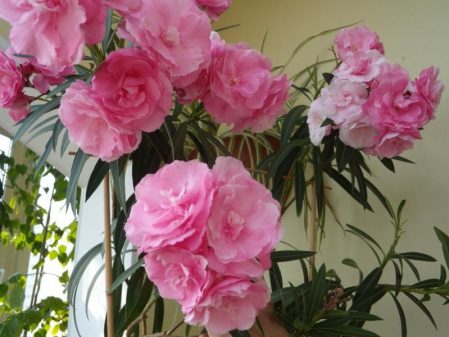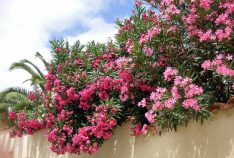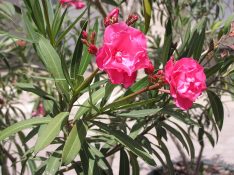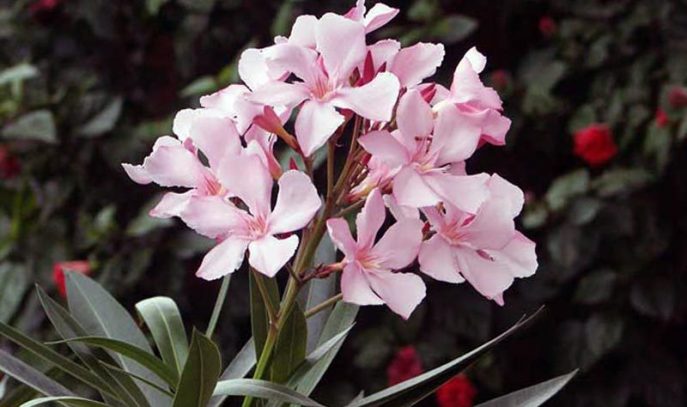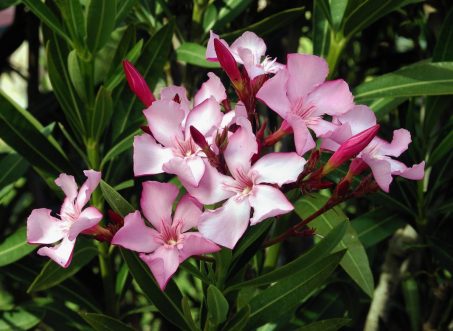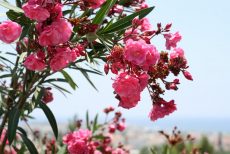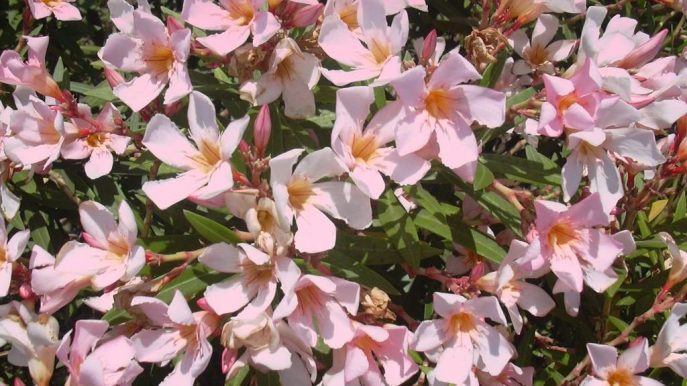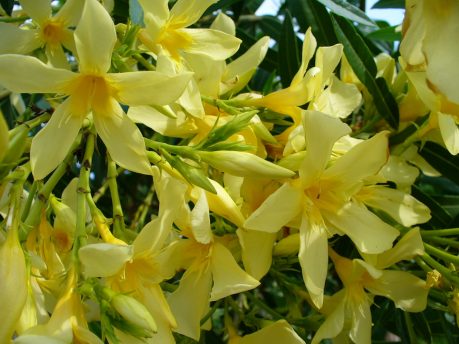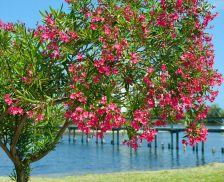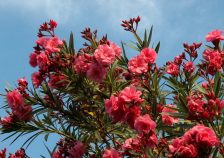Not everyone knows that even in Siberia, oleander can be successfully grown at home, and care should be special. Due to its size and exactingness to air temperature, there are a number of conditions for such an activity that must be fulfilled.
Material Content:
- 1 Varieties suitable for growing in an apartment
- 2 Growing Features
- 3 What are the requirements for soil
- 4 Creation of necessary conditions
- 5 How to carry out watering?
- 6 Fertilizer use
- 7 How to prune oleander bushes correctly
- 8 Transplantation of a room oleander
- 9 How does a plant breed
- 10 Seed cultivation
- 11 Diseases and pests of a room oleander
- 12 Common problems for gardeners with a room oleander
Varieties suitable for growing in an apartment
Breeders bred many varieties of oleander. Basically, they differ from each other in color, shape, aroma and size of their flowers. And for growing in an apartment there are much fewer options, or rather, only one - an ordinary room oleander. This ornamental shrub has small sizes and bright, green leaves with short petioles, similar in appearance to a medical lancet. Oleander fell in love with flower growers because he blooms very beautifully and luxuriously. Its buds have some external resemblance to rosebuds and come in various colors.
The following varieties are distinguished:
- “Elegance” is a fairly large plant with a palette of petals ranging from pale pink to apricot. The aroma exuded by the buds is sweet and reminiscent of fruit.
- “Variegata” - in the variety, terry petals are not wide and slightly elongated, and the flowers themselves have a very pleasant aroma.
- "Soleil Levant" - a variety characterized by a stable aroma and the presence of large, pink inflorescences with a yellow base.
- “Hardyred” - in a plant of this variety the flowers have a thick red color and a not very noticeable fruity aroma. They are relatively small in size, with semi-double petals.
- “Cardinal” - has a wide color gamut of inflorescences, the petals are smooth, and the aroma is light, fruity.
- "Mont Blanc" - the plant usually has white, luxurious flowers, which are very many. They have a rounded bud shape and smell good.
- “Petite Salmon” is a dwarf variety, characterized by a modest, compact size (not higher than 40 cm) and beautiful peach blossom inflorescences.
- "Rigoletto" - this oleander has pinkish double flowers, the petals of which twist to the center.
When planning to grow an oleander at home, you should not worry at all that he will have little space. Firstly, there are many dwarf plant varieties on sale, and secondly, it can be safely cut.
Many are convinced that the flower positively affects the atmosphere in the house. Helps to tolerate negativity easier and promotes good mood. Admiring its beautiful flowers and breathing in their pleasant smell, a person copes with stress faster and can even get rid of smoking.
Growing Features
This ornamental shrub blooms from June to October. Accordingly, it must be cut in late autumn and winter, as if in advance, setting the necessary shape for the future flowering bush. Oleander loves the sun very much, and if there is not enough light, phytolamps specially designed for this should be used to illuminate the plants.
At low light, the color of the leaves changes, the number of inflorescences decreases and growth slows down. An equally important parameter for normal development is temperature. Its optimal value will be, within + 20 ℃ - + 25 ℃.
In the summer months, the plant feels quite comfortable if it is taken out to the balcony or taken to the cottage, and in winter it needs to choose a lighter place and so that the temperature is not lower than + 2 ℃ - + 12 ℃. The same applies to irrigation: when the growing season, water the plant more often, and less often in winter. But drying out the soil should not be allowed. The leaves are sprayed from the spray gun, and so that they do not fall prematurely, the water should not be cold.
What are the requirements for soil
This shrub prefers loamy soils. A mixture of turf land, sand and peat is perfect, either acid-neutral, soil from shops. The main thing is that there is good drainage.
Creation of necessary conditions
Oleander is a native of the South. For this reason, gardeners should pay special attention to its illumination and temperature conditions. If you put a flowerpot with a bush in a shady place, this will entail:
- old leaves will surely begin to fade, and new ones will fade;
- there will be fewer flowers, and they will not be as lush, fragrant and beautiful as they should;
- internodes of young shoots will stretch;
- new growth will be plain and frail.
The lack of sunlight violates absolutely all processes and very detrimental to the plant. Phytolamps help solve this problem, but do not neglect help from nature itself. With the advent of summer, you need not to be lazy and have an oleander sunbathing on the balcony or in the open air. At a temperature of + 20 ℃ - + 25 ℃, the plant will feel comfortable on the street, but in no case should it be transplanted from the pot for this period. Firstly, this is not advisable, given the transience of summer days, and secondly, with any, even the most accurate transplant, the root system is damaged and this is unnecessary stress for the plant.
It is recommended that a flowerpot with a room oleander be dug a little next to the pool, if there is one on the site. Or put any container of water near the bush.
Important! This ornamental plant hardly tolerates the musty air in the room. Airing should be frequent and should be done periodically. But, at the same time, you should beware of cold drafts.
- How to determine the place for the oleander plant?
- Air temperature requirements
- Lighting Requirements
If there is such a possibility, the flowerpot with oleander should be placed where, during the day, the sun's rays will most likely fall on it.But, if this is not possible, and the apartment windows face the north side, and not south or east, then the plants can not do without lighting. Especially in the winter months. Flowerpots with dwarf varieties of shrubs or young plants, it is recommended to put on a windowsill, stand, or hang on the wall. And adults and fairly tall oleander flowers are allowed to be placed on the floor.
Oleander does not need the presence of very high temperatures for normal development. He will feel quite comfortable if on a thermometer column in summer the temperature fluctuates between + 22 ℃ + 25 ℃ and in winter within + 10 ℃ - + 15 ℃. The transition to winter temperature should be carried out gradually, reducing the temperature daily by one degree. Do this if there is no temperature controller on the battery, by additional ventilation of the rooms. In winter, a room oleander is not the best neighbor for plants that are excessively thermophilic. He is even able to cope with frost, but prolonged minus temperatures are fatal for him.
This plant is not afraid of direct sun exposure. No wonder it comes from the southern regions. On the contrary, all concerns are related to how to ensure the illumination of plants in winter in the required amount. To do this, resort to illuminating the oleander with phytolamps.
How to carry out watering?
The oleander flower does not need frequent and plentiful watering, but it needs a certain humidity of the outside air. Therefore, on a sultry day, a container of water should be placed next to the indoor plant so that it maintains the necessary humidity during evaporation. For the same purpose, frequent spraying of the bush is also used.
There should be good drainage in the flowerpot with the plant, which ideally should always be slightly moist, but not allow the water to stagnate. Oleander is better suited to basal nutrition, when moisture does not come from above, but from below from a pallet. The amount of watering is significantly reduced with the onset of winter. It must be remembered that improper drainage or lack thereof, as well as excessive watering, leads to inhibition of aeration, decay of the root system and, ultimately, to the death of the plant.
Fertilizer use
Soils in nature are being restored, thanks to the tireless activity of microbes. In a flowerpot with a plant, the number of these microbes for various reasons decreases over time. Experienced flower growers know that the soil in pots needs to be changed every few years. For the same reason (lack of nutrients), you should periodically feed the plants so that they can grow and develop normally, without experiencing a lack of anything.
But you need to remember that all fertilizers have their own purpose. The labels usually indicate which plants the complex is intended for: indoor, heat-loving, flowering, light-loving, bush, etc. An oleander plant is fed every 14 days (except for autumn and winter), trying to find the time so that the weather is cloudy and not hot.
How to prune oleander bushes correctly
Oleander is a perennial ornamental plant. Subject to all the rules for care, when there is nothing shortage, the shrub actively grows, blooms and develops.
For this reason, the plant (usually in autumn or winter) needs to be pruned. The bushes tolerate this procedure without problems, and new buds with the advent of spring more than compensate for the damage to the crown. Moreover, thanks to such manipulations with scissors, the shape of the bush will be even more beautiful.
In spring, the bushes do not “trim” (except perhaps infected shoots), since buds of future flowers have already been formed by this time and are just waiting in the wings to blossom.
Transplantation of a room oleander
Small plants, as they grow (approximately once a year), it is recommended by transshipment to place them in larger pots, while adding additional soil. If you carry out this procedure carefully, the roots are practically not damaged.
Bushes that are already several years old must be transplanted into more spacious flower pots at least once in 4 years.Soil can be purchased at the store or prepare the mixture yourself. It will be useful to add some charcoal to fresh soil to reduce the risk of oleander infectious diseases.
How does a plant breed
Often, when transplanting a plant, it is "divided", thus obtaining another one. Although flower growers, for this purpose, prefer the use of cuttings.
This is done in this way: a healthy bush is selected, from which cuttings with a growth point and several leaves are cut. They are subsequently rooted during the growing season, placing the cuttings in a peat-sand mixture with the addition of perlite. A pot with cuttings is covered with polyethylene and placed in a greenhouse. After the cuttings release 3-5 cm roots, they can be moved to separate flowerpots.
Another similar method looks like this: after dissolving a little charcoal in a transparent container with water, cuttings are placed in it. With the advent of roots, young oleanders are moved into pots with soil. And after a year they can be carefully “cut”, after which they will become better to scrub and get a thick crown.
Seed cultivation
Usually, several seeds are sold in a package, therefore, it is prudent to buy two or three packages, since germination is not always 100%.
Although the seeds are processed before packaging, it will not be superfluous to once again affect them with a fungicide and a growth stimulant. Having prepared the seeds, they are barely sprinkled with soil in the seedling containers, moistened and covered with polyethylene.
- At this stage, the temperature should exceed + 30 ℃, so the place is looking for warmer.
- As soon as the first shoots are noticeable, the film can be removed. Since the roots are not deep, you should not allow the soil to dry out and control watering.
- The movement of plants in individual flowerpots occurs in the phase of 2-3 full leaves. It must be remembered that the diameter and volume of pots for plants must correspond to their size.
Diseases and pests of a room oleander
The plant is most affected by the red spider mite. To determine why a plant is unwell, you can notice a thin web. The foliage begins to become like a “marble”, gradually tapering, turning yellow and falling.
A fairly effective way to combat the tick is to remove the affected leaves and treat healthy leaves with an alcohol or soap solution, plus rinsing under a sufficiently hot shower. Use chemicals, such as Actellic, is only in the most advanced cases.
Another, no less dangerous “enemy” is the mealybug. The symptoms that speak of his attack look like this: copper dew appears on the flowers, and the foliage is covered with a kind of waxy coating, like talcum powder, it gradually turns yellow and falls. The control method is similar to the previous one - use kerosene or alcohol for disinfection, pick off infected leaves. You can "hook" a ladybug on an oleander, which will destroy the worm. In severe cases, chemicals are used.
Having discovered that the foliage and stems of the plant began to “stick” to the fingers, the same steps should be taken as already described above. A shield has attacked the plant and, if the pest is not fought, it may die.
Common problems for gardeners with a room oleander
Often, the foliage of a plant dries and falls. Her color changes or she almost completely stops growing. To identify the cause of such disturbing manifestations, some gardeners succeed by carefully looking at the plant.
- the foliage on the tips turns yellow and dries - watering is necessary;
- leaves fall from below - the plant lacks light; you need to "highlight" it;
- modest, inactive flowering - non-compliance with one of the parameters: the level of illumination, the temperature is lower than necessary, not enough moisture.



